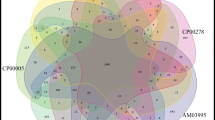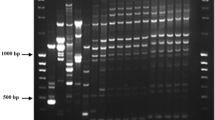Abstract
By cloning and sequencing specific randomly amplified polymorphic DNA (RAPD) products, we have developed pairs of PCR primers that can be used to detect Xylella fastidiosa in general, and X. fastidiosa that cause citrus variegated chlorosis (CVC) specifically. We also identified a CVC-specific region of the X. fastidiosa genome that contains a 28-nucleotide insertion, and single base changes that distinguish CVC and grape X. fastidiosa strains. When using RAPD products to develop specific PCR primers, we found it most efficient to screen for size differences among RAPD products rather than presence/absence of a specific RAPD band.
Similar content being viewed by others
Literature Cited
Akopyanz N, Bukanov NO, Westblom TU, Kresovich S, Berg DE (1992) DNA diversity among clinical isolates of Helicobacter pylori detected by PCR-based RAPD fingerprinting. Nucleic Acids Res 20:5137–5142
Ausubel FM, Brent R, Kingston RE, Moore DD, Seidman JG, Smith JA, Struhl K (1994) Current Protocols in Molecular Biology, Volume 1. New York: Current Protocols, pp 1.1.2–2.4.1.
Barry T, Colleran G, Glennon M, Dunican LK, Gannon F (1991) The 16s/23s ribosomal spacer region as a target for DNA probes to identify eubacteria. PCR Methods Appl 1:51–56
Boyer HW, Roulland-Dussoix D (1969) A complementation analysis of the restriction and modification of DNA in Escheria coli. J Mol Biol 41:459–472
Brlansky RH, Timmer LW, French WJ, McCoy RD (1983) Colonization of the sharpshooter vectors, Oncometopia nigricans and Homalodiscus coagulata, by xylem limited bacteria. Phytopathology 73:530–535
Chang CJ, Garnier M, Zreik L, Rossetti V, Bove JM (1993) Culture and serological detection of the xylem-limited bacterium causing citrus variegated chlorosis and its identification as a strain of Xylella fastidiosa. Curr Microbiol 27:137–142
Davis MJ, French WJ, Schaad NW (1981) Axenic culture of the bacteria associated with phony disease of peach and plum leaf scald. Curr Microbiol 6:309–314
Gottwald TR, Gidtti FB, Santos JM, Carvalho AC (1993) Preliminary spatial and temporal analysis of citrus variegated chlorosis in Brazil. In: Moreno P, DaGraca JV, Timmer LW (eds) Proceedings of the 12th conference of the international organization of citrus virologists. Riverside, California: International Organization of Citrus Virologists (IOCV).
Hartung JS, Civerolo EL (1987) Genomic fingerprints of Xanthomonas campestris pv. citri strains from Asia, South America, and Florida. Phytopathology 77:282–285
Hartung JS, Beretta J, Brlansky RH, Spisso J, Lee RF (1994) Citrus variegated chlorosis bacterium: axenic culture, pathogenicity, and serological relationships with other strains of Xylella fastidiosa. Phytopathology 84:591–597
Hayashi K (1994) Manipulation of DNA by PCR. In Mullis KB, Ferre F, Gibbs RA (eds) The Polymerase Chain Reaction. Boston: Birkhauser.
Hopkins DL (1988) Production of diagnostic symptoms of blight in citrus inoculated with Xylella fastidiosa. Plant Dis 77:432–435
Lee RF, Kerrick KS, Beretta MJG, Chagas CM, Rosetti V (1991) Citrus variegated chlorosis: a new destructive disease of citrus in Brazil. Citrus Ind 72:12–13, 15
Minsavage GV, Thompson CM, Hopkins DL, Leite RMVBC, Stall RE (1994) Development of a polymerase chain reaction protocol for detection of Xylella fastidiosa in plant tissue. Phytopathology 84:456–461
Paran I, Michelmore RW (1993) Development of reliable PCR-based markers linked to downy mildew resistance genes in lettuce. Theor Appl Genet 85:985–993
Pooler MR, Hartung JS (1995) Genetic relationships among strains of Xylella fastidiosa based on RAPD-PCR data. Curr Microbiol, in press
Ritchie DF, Klos EF (1977) Isolation of Erwinia amylovora from aerial parts of apple trees. Phytopathology 67:101–104
Roberts DP, Sheets CJ, Hartung JS (1992) Evidence for proliferation of Enterobacter cloacae on carbohydrates in cucumber and pea spermosphere. Can J Microbiol 38:1128–1134
Rosetti V, Garnier M, Bove JM, Beretta MJ, Teixeira ARR, Quaggio JA, DeNegri JD (1990) Presence de bacteries dan le xylem d'orangers atteint de chlorose variegee une nouvelle maladie des agrumes au Brazil. C.R. Acad. Sci. III 310:345–349
Williams JGK, Kubilik AR, Livak KJ, Rafalski JA, Tingey SV (1991) DNA polymorphisms amplified by arbitrary primers are useful as genetic markers. Nucleic Acids Res 18:6531–6535
Author information
Authors and Affiliations
Rights and permissions
About this article
Cite this article
Pooler, M.R., Hartung, J.S. Specific PCR detection and identification of Xylella fastidiosa strains causing citrus variegated chlorosis. Current Microbiology 31, 377–381 (1995). https://doi.org/10.1007/BF00294703
Issue Date:
DOI: https://doi.org/10.1007/BF00294703




